Once upon a time there was a beautiful garden with many beautiful flowers. Everyday a fuzzy bumblebee came to the garden to collect pollen. One day as the bumblebee was busy buzzing from flower to flower a lovely butterfly, tired from a long journey, floated into the garden and flitted to a flower nearby (Cosmos 'Psyche White', if you must know. After all, this is a morality tale written by a horticulturist!). As the butterfly sipped the delicious nectar, it watched the bumblebee busily at work.
"Gosh, that bumblebee sure is working hard! Look at all that pollen it has collected!", said the butterfly. When the bumblebee noisily crawled into a nearer flower (Salvia uliginosa, since I know you're going to ask), the butterfly asked, "Why are you so busy collecting so much pollen?"
The bumblebee buzzed about in the flower then came out and hovered near the butterfly, its diaphanous wings beating so fast that the draft caused the butterfly's large, bright wings to quiver. "Why, I'm gathering food for my nest," he said. Then it dove into another blossom and scrambled around. When he came out he said, "And I'm helping to pollinate these flowers so they'll set seed and grow next year. More flowers next year means more food for my nest!"
"Wow!", said the butterfly, "I'm not carrying that much pollen on my feet. Even though I visit many flowers, I'd better step it up if I'm going to keep up with the bumblebee!" And the butterfly began to collect more pollen on its long, thin legs.
The butterfly went from bloom to bloom collecting pollen but as time went on she found it harder and harder to fly from one flower to the next. She grew tired, but kept telling herself she needed to keep up with the bumblebee. Soon the beautiful butterfly had collected several sunny beads of pollen and was ready to continue her journey south. After one last sip of nectar, she left the flower and tried to fly. Instead of flitting lightly along she struggled, weighed down by the pollen, every flap of her colorful wings a tiring effort. Soon she was forced to land and rest. Then she heard the bumblebee coming back and the constant buzz-buzz-buzzing of it's wings as it quickly flew from flower to flower. When the bumblebee came up for air, the butterfly asked him another question.
"How can you carry all that pollen? It's so heavy, and I've got such a long way to go!".
"I don't know, I just do. My nest is close by. I collect the pollen, take it to my nest, then come back for more. See ya!" and the busy bumblebee buzzed away.
"But I've got so far to go," said the butterfly. "If I carry all this pollen, I'll never be able to keep up with my friends when we fly south". And unable to fly away, the beautiful butterfly was eaten by a bird.
The End
(hey, not all endings are happy ones)
Heaven knows how some thoughts pierce the gray matter while I lie awake at 5am listening to a rumbling thunderstorm and wishing I could go back to sleep. However they manage, they get in and bounce around, thwarting sleep and demanding to be looked at, turned around, ruminated on, analyzed, and bounced some more. This morning as the sky lit up like a pinball machine with thunder growling angrily (along with my stomach), I kept thinking about butterflies and bees (no, not birds and bees, this is not that kind of blog!).
Maybe it was a line from the movie Jurassic Park, which I watched before bedtime, where the heroic paleontologist has just rescued two kids from the menacing T-Rex and are hiding up a tree. When they awake in the morning, the tree branches are being eaten by a docile herbivore. The girl freaks, fearing it's another meat-a-saurus, but the daring doctor reassures her it's not. "They just do what they do", he says, which can be said of the carnivores, as well, I suppose.
Maybe it was the article I read about a woman who swore off mirrors for a year in order to develop a better body image. And who doesn't need one of those, what with the constant barrage of beauty ads, cosmetic surgery commercials, and weight loss gimmicks around every turn? I can say from personal experience that after living half a year in an ancient house with no television, very little radio, and only the occasional fashion magazine (it was fascinating to see how they differ in the UK compared to the US), I was much happier and - dare I say - saner.
To my knowledge, Homo sapiens is the only species on the planet pre-occupied with being something it isn't, and which has taken that pre-occupation and turned it into a bazillion dollar industry. Magazine ads and television commercials are designed to make us feel inferior in the hopes of duping us to buying the products and services touted. If we buy these clothes, use this product, or undergo this treatment we'll look younger, be slimmer, feel sexier, be more desirable to the opposite sex.
Riiiiiiiiight!
Notice the humble bumble in the story never once tried to convince the butterfly it was an inferior creature, nor did it boast of its own capabilities. It just did what Bombi do. Oh sure, there's competition in nature - you only have to look at "survival of the fittest" research to see that. Heck, you only have to see how grass weeds crowd out desirable perennials in a garden, but I'll bet you all the Camellia sinensis in China that not one of those weeds has ever said to itself, "Gosh, I wish I was a Silene 'Blue Angel'; then everyone would love me!". Only humans wish such absurd things and who are we to deny what we are meant to be? Taking it a step further, who are we to tell others what they should be?
Time for full disclosure: as I get older I admit to wishing I were young(er) again. Or at least that I looked like I did when I was younger (i.e. thinner, in better shape, with longer hair, and fewer strands of tinsel) but there's one important lesson that my friendships with those of the more youthful generation have taught me, and that is that I have mad skills and knowledge which I've worked hard to develop over time, and only with time do those skills and knowledge become as mad as they are! Perhaps I'm not so good at designing a garden, but I'm one hell of a pricker-outer, and garden designers wouldn't have the plants to design the garden with if there wasn't someone to grow them. So there. Nyah. Would I trade my hard-earned madness for youth? No way!
As the thunderstorm continued on its course and the rumblings died down, I wondered what the world would be like if people stopped trying to be something they aren't and invested that time in being content with who they are and what they have instead of always trying to keep up with the Joneses. What if they spent that time being who they are meant to be, depending less on what the mirror says, and focusing more on doing what they were created to do? The bumblebee doesn't try to be a butterfly, and the butterfly doesn't try to be a bee. Not only would it be an exercise in futility, they would be too busy trying to be something else that they wouldn't be doing what nature needs them to do, which would surely domino into a collapse of the space-time continuum leading to fire and brimstone coming down from the sky, rivers and seas boiling, forty years of darkness, earthquakes, volcanoes, dogs and cats living together, mass hysteria (guess who's been watching too much cable!?)!
Bumblebees and butterflies are what they are and they both contribute to the world going round in their own unique and invaluable ways. Just for kicks and giggles, I've posted a chart comparing the two.
I guess what I'm asking is who are we? Not in the existential, Nietzsche-esque sense of the phrase, but who are we to imply that someone else isn't good enough? We all play an important part in the grand scheme, whether one is a doctor, a chef, a gardener, or a trash collector. I grant that not many kids exclaim wanting to be a trash collector when they grow up but just imagine where we'd be without them. I shudder at the thought!
And so to send you on your merry way, here's an inspirational yet in-your-face video featuring one of my all time favorite heroines in fiction to motivate you to step away from the mirror and go out there and be you!
Oh, by the way, there's an alternate ending to the story of the butterfly: the bird she encounters is a robin, those feisty yet adorable ornaments of the garden so often portrayed in fiction as good guys. In an act of tough love the robin smacks Miss Butterfly upside the thorax, asks what the heck she thinks she's doing trying to be a bumblebee and putting holes in the space-time continuum, knocks the pollen off and sends her on her merry way to Mexico, during which arduous journey she lays eggs and when her great-great-great-great grandchildren stop for a rest in that same garden, the kindly robin tells them the story of the Bumblebee and the Butterfly.
Fun Facts: Bumblebee vs. Butterfly
Bumble-bee (genus Bombus) Butterfly (Monarch)
4 wings beat at 130-240 beats/second 4 wings beat at 5-12 beats/second
Cannot fly if wing muscle temp is below Cannot fly in the rain
30°C
Flight speed avg. 8.7 mph Flight speed avg. 3.7 mph
"central place foragers"; the central Migratory, traveling over 2,000 miles
place is their nest. They fly out, forage,
and fly back
Weight: 0.04 - 0.60 grams Weight: 0.27 - 0.75 grams
Female workers can carry their whole Collects pollen on their feet as they walk on flowers
weight in pollen
Cannot see the color red Can see more colors than humans or bees,
including red
Source: http://www.bumblebee.org/ http://www.learner.org/
Showing posts with label bees. Show all posts
Showing posts with label bees. Show all posts
24 August 2011
18 August 2009
One bee makes no swarm...
But thousands of them definitely do!
Imagine yourself spending an industrious afternoon mowing a vast expanse of lawn. It's not a bad job. After all, it's a ride-on mower! So there you are minding your own business, mowing away, when you turn a corner and see this:

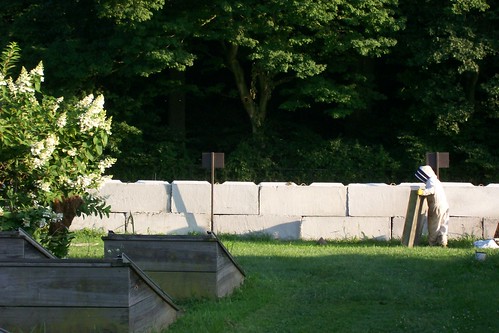
 Once the pallet and boxes were in place and level, Emma spread a sheet on the ground under the swarm. Now, keep in mind, we in the gallery were standing about 20-30' away. Far enough that the swarming bees took no interest in us but close enough that we could see hundreds - nay, thousands - of them forming a cloud around Emma as she worked, and none of it seemed to phase her. She moved with care but also seemed completely relaxed and confident in what she was about to do. I'm not sure the rest of us would have been so brave.
Once the pallet and boxes were in place and level, Emma spread a sheet on the ground under the swarm. Now, keep in mind, we in the gallery were standing about 20-30' away. Far enough that the swarming bees took no interest in us but close enough that we could see hundreds - nay, thousands - of them forming a cloud around Emma as she worked, and none of it seemed to phase her. She moved with care but also seemed completely relaxed and confident in what she was about to do. I'm not sure the rest of us would have been so brave.

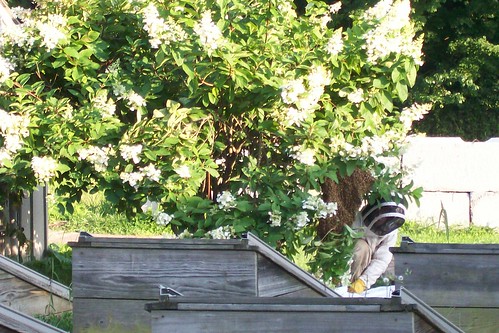 Once the sheet was spread below the swarm, the branch was lopped off and the whole thing fell onto the sheet. Needless to say, this made the bees a little agitated and the cloud around Emma thickened as they began to flurry around.
Once the sheet was spread below the swarm, the branch was lopped off and the whole thing fell onto the sheet. Needless to say, this made the bees a little agitated and the cloud around Emma thickened as they began to flurry around.
 Folding up the four corners of the sheet to envelope the branch, she carried it over to the new hive.
Folding up the four corners of the sheet to envelope the branch, she carried it over to the new hive.

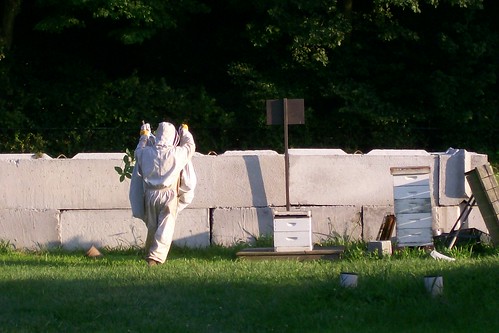 Laying the sheet and branch carefully at the hive opening.
Laying the sheet and branch carefully at the hive opening.
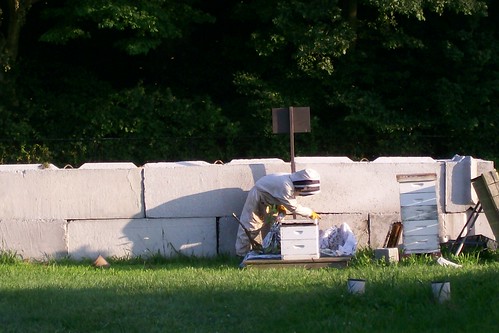
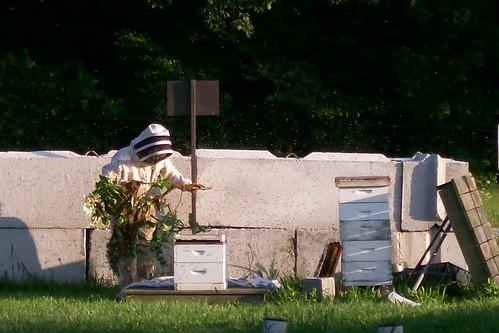 Mission accomplished, Emma slowly walked away from the hive and let the bees get used to their new home. She very wisely used inserts (the part the bees make the combs and honey on) from the original hive, so the swarm actually smelled their own pheromones and honey and immediately began marching into the new hive!
Mission accomplished, Emma slowly walked away from the hive and let the bees get used to their new home. She very wisely used inserts (the part the bees make the combs and honey on) from the original hive, so the swarm actually smelled their own pheromones and honey and immediately began marching into the new hive!
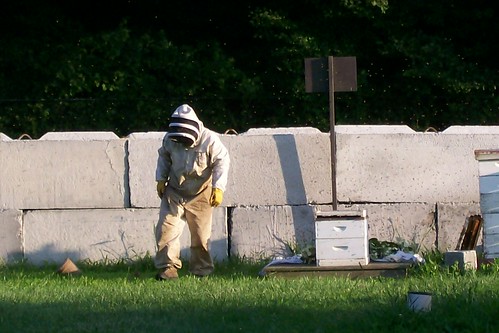 Now, the bees that were swarming were still hot on the trail of the queen bee's scent so the cloud followed Emma and her bundle but others continued to swarm onto the cut branch in the Hydrangea. What to do about them?
Now, the bees that were swarming were still hot on the trail of the queen bee's scent so the cloud followed Emma and her bundle but others continued to swarm onto the cut branch in the Hydrangea. What to do about them?

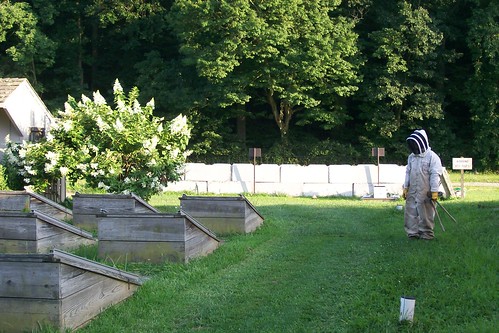 The smaller swarm was cut and taken to join their comrades at the hive. Here it is up close, and you can see the bees entering the box.
The smaller swarm was cut and taken to join their comrades at the hive. Here it is up close, and you can see the bees entering the box.

 This was one of those spectacles that you simply had to witness first hand to appreciate. If our adrenaline was pumping - and it was - I can't imagine what was coursing through Emma's veins! In the end, the swarm adopted their new home and now, thanks to Emma's courage and heroism, there are two active hives here on the Row.
This was one of those spectacles that you simply had to witness first hand to appreciate. If our adrenaline was pumping - and it was - I can't imagine what was coursing through Emma's veins! In the end, the swarm adopted their new home and now, thanks to Emma's courage and heroism, there are two active hives here on the Row.
Saint John Chrisostum once said, "The bee is more honored than other animals, not because she labors, but because she labors for others". Today I give honor to Emma, who labored for others - not just the bees, but in consideration of the safety of those who live on the Row. Kerry-Ann proclaimed that Emma is the bravest person she's ever known and I have to say I agree.
Bravo, Emma! You're awesome!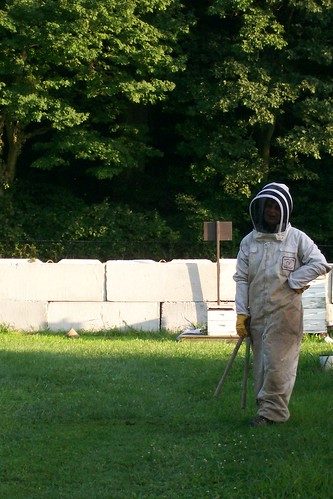
Imagine yourself spending an industrious afternoon mowing a vast expanse of lawn. It's not a bad job. After all, it's a ride-on mower! So there you are minding your own business, mowing away, when you turn a corner and see this:
 What lovely Hydrangeas, you say. But what's that dead branch there on the left? Being the conscientious Professional Gardener Student that you are, you decide to take a closer look...
What lovely Hydrangeas, you say. But what's that dead branch there on the left? Being the conscientious Professional Gardener Student that you are, you decide to take a closer look... If you were me, you might ask yourself, "What's that turkey doing hanging from the Hydrangea bush?" But you are not me and you know it's not a turkey or any other barnyard fowl, for that matter. You know without a shadow of a doubt it's a swarm of bees!
If you were me, you might ask yourself, "What's that turkey doing hanging from the Hydrangea bush?" But you are not me and you know it's not a turkey or any other barnyard fowl, for that matter. You know without a shadow of a doubt it's a swarm of bees!


This is exactly what happened to my esteemed colleague Kerry-Ann last Friday evening. Being of sound mind and judgement, she immediately sought out my classmate Emma, who is an experienced bee-keeper. I happened on the scene a little later in the proceedings but was in time to watch as Emma set up a new hive in hopes that the swarm could be coaxed back into it.
Here's what happened: the existing hive behind the student greenhouse had gotten a bit cramped for the bees already in residence. When this happens - sometimes a few times a season - the bees within rear a new queen and prepare to swarm. Those who are about to set off and establish a new hive drink as much honey as they can as fuel for the journey. When everyone's ready, they follow the new queen to her chosen destination and set to work building a new home.
In this case, the queen didn't go very far - only about 30-feet from the original hive. Luckily she went toward the student gardens to a shrub that was manageable as far as height. Had she gone toward the woods or into a taller tree, retrieving the swarm would have been much more difficult and dangerous.
Here's what happened: the existing hive behind the student greenhouse had gotten a bit cramped for the bees already in residence. When this happens - sometimes a few times a season - the bees within rear a new queen and prepare to swarm. Those who are about to set off and establish a new hive drink as much honey as they can as fuel for the journey. When everyone's ready, they follow the new queen to her chosen destination and set to work building a new home.
In this case, the queen didn't go very far - only about 30-feet from the original hive. Luckily she went toward the student gardens to a shrub that was manageable as far as height. Had she gone toward the woods or into a taller tree, retrieving the swarm would have been much more difficult and dangerous.


 Once the pallet and boxes were in place and level, Emma spread a sheet on the ground under the swarm. Now, keep in mind, we in the gallery were standing about 20-30' away. Far enough that the swarming bees took no interest in us but close enough that we could see hundreds - nay, thousands - of them forming a cloud around Emma as she worked, and none of it seemed to phase her. She moved with care but also seemed completely relaxed and confident in what she was about to do. I'm not sure the rest of us would have been so brave.
Once the pallet and boxes were in place and level, Emma spread a sheet on the ground under the swarm. Now, keep in mind, we in the gallery were standing about 20-30' away. Far enough that the swarming bees took no interest in us but close enough that we could see hundreds - nay, thousands - of them forming a cloud around Emma as she worked, and none of it seemed to phase her. She moved with care but also seemed completely relaxed and confident in what she was about to do. I'm not sure the rest of us would have been so brave.
 Once the sheet was spread below the swarm, the branch was lopped off and the whole thing fell onto the sheet. Needless to say, this made the bees a little agitated and the cloud around Emma thickened as they began to flurry around.
Once the sheet was spread below the swarm, the branch was lopped off and the whole thing fell onto the sheet. Needless to say, this made the bees a little agitated and the cloud around Emma thickened as they began to flurry around. Folding up the four corners of the sheet to envelope the branch, she carried it over to the new hive.
Folding up the four corners of the sheet to envelope the branch, she carried it over to the new hive. 
 Laying the sheet and branch carefully at the hive opening.
Laying the sheet and branch carefully at the hive opening.
 Mission accomplished, Emma slowly walked away from the hive and let the bees get used to their new home. She very wisely used inserts (the part the bees make the combs and honey on) from the original hive, so the swarm actually smelled their own pheromones and honey and immediately began marching into the new hive!
Mission accomplished, Emma slowly walked away from the hive and let the bees get used to their new home. She very wisely used inserts (the part the bees make the combs and honey on) from the original hive, so the swarm actually smelled their own pheromones and honey and immediately began marching into the new hive! Now, the bees that were swarming were still hot on the trail of the queen bee's scent so the cloud followed Emma and her bundle but others continued to swarm onto the cut branch in the Hydrangea. What to do about them?
Now, the bees that were swarming were still hot on the trail of the queen bee's scent so the cloud followed Emma and her bundle but others continued to swarm onto the cut branch in the Hydrangea. What to do about them? 
 The smaller swarm was cut and taken to join their comrades at the hive. Here it is up close, and you can see the bees entering the box.
The smaller swarm was cut and taken to join their comrades at the hive. Here it is up close, and you can see the bees entering the box.
 This was one of those spectacles that you simply had to witness first hand to appreciate. If our adrenaline was pumping - and it was - I can't imagine what was coursing through Emma's veins! In the end, the swarm adopted their new home and now, thanks to Emma's courage and heroism, there are two active hives here on the Row.
This was one of those spectacles that you simply had to witness first hand to appreciate. If our adrenaline was pumping - and it was - I can't imagine what was coursing through Emma's veins! In the end, the swarm adopted their new home and now, thanks to Emma's courage and heroism, there are two active hives here on the Row.Saint John Chrisostum once said, "The bee is more honored than other animals, not because she labors, but because she labors for others". Today I give honor to Emma, who labored for others - not just the bees, but in consideration of the safety of those who live on the Row. Kerry-Ann proclaimed that Emma is the bravest person she's ever known and I have to say I agree.
Bravo, Emma! You're awesome!

*Special thanks to Kerry-Ann for allowing me to use her photos.
Labels:
bees
Subscribe to:
Posts (Atom)





